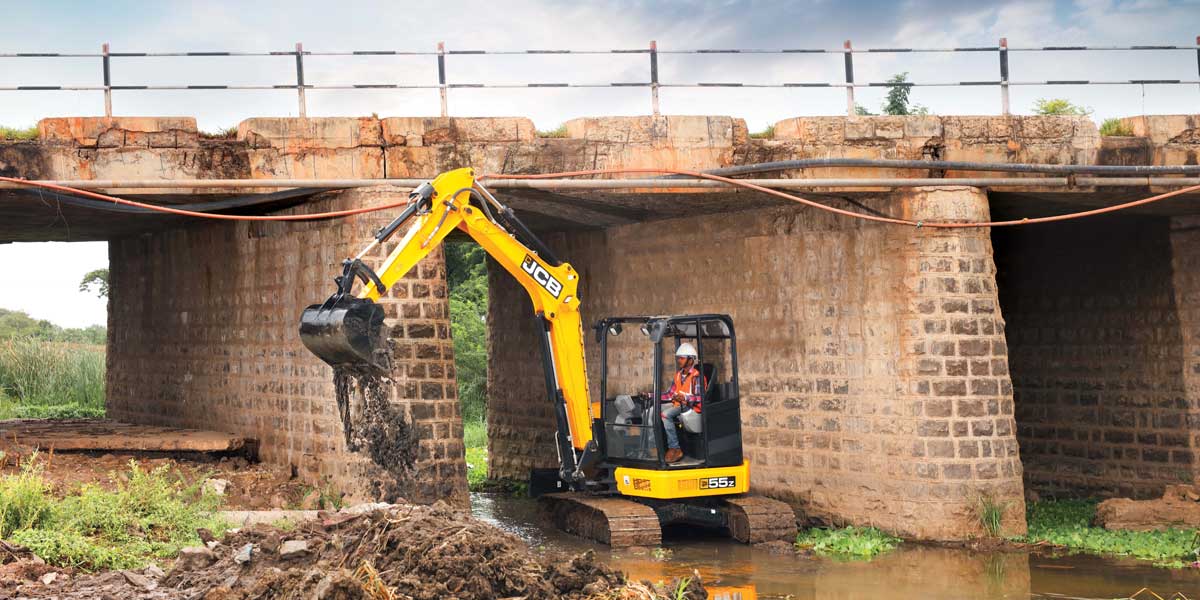In the mini-equipment space, after late June 2020, experts say, there has been a sudden rise in the sales of compact excavators, compactors, loaders, and other equipment segments, as manpower shortages owing to labour migration forced contractors to look at alternatives for quick completion of projects. Overall, the construction equipment industry witnessed 20% year-on-year volume growth in Q2FY21, followed by double digit growth in October and November 2020. Machines were even launched right in the middle of the pandemic. This article analyses how innovation will create new applications for the mini segment, while government investments will spur demand.
_________
Overall, the construction equipment industry witnessed 20% year-on-year (YoY) volume growth in Q2FY21, followed by double digit growth in October and November 2020, observes Rahul Shorey, Head - Construction Equipment, Tata Hitachi.
In the mini-equipment space, after late June 2020, Dheeraj Panda, Director of Sales, Marketing and Customer Support, Sany Heavy Industry India, attests to having seen a sudden rise in the sales of compact excavators, compactors, loaders, and other equipment segments, as manpower shortages owing to labour migration forced contractors to look at alternatives for quick completion of projects.
The outlook in the current fiscal remains positive on the back of robust government infrastructure investment, continues Shorey. “In particular, highway construction and awards for April to December FY21 have increased by 12% and 110% respectively. In December 2020 alone, 1,560 km of highways were constructed, up ~60% YoY. Moreover, the extension of relaxations under Schedule-H [relief measures owing to Covid-19] till June 30, 2021, has provided good liquidity to contractors and will help maintain the pace of highway construction. Twenty-three expressways have been announced with target completion dates between March 2023 and March 2025.”
Shorey also sees robust rural demand as a key driver that has played a major role in the revival of the economy so far.
Trending models
Sany’s most popular mini-excavator is the SY35U. This and other excavators are loaded with an advanced telematics system, zero tail swing, boom swing, and boom offset as standard features. Cabin and canopy options are also available with the SY27 model to meet all-terrain requirements.
Customers have started exploring the use of different attachments for different applications of mini-excavators, observes Panda. “The rental market accounts for major demand for mini excavators, mainly in the South. This trend will spread to other parts as well in the near future as machines help deal with labour shortages and speedily complete projects.”
Launches
Tata Hitachi launched the mini-marvel TMX 20 neo Super+ series mini-excavator in February 2021. With this, its mini-excavator line-up now includes the TMX 20 Neo, ZX20U and ZAXIS 23U in the 2-tonne category and ZAXIS 33U in the 3-tonne category. The ZX20U and ZX33U come with zero tail swing, enabling workability in very tight spaces, full metallic covers for greater durability and open wide to allow easy maintenance. Radial air filters and air pre-cleaner helps take care of Indian site conditions. Both these machines are easily transportable to remote sites—the Tata Hitachi ZX20U can be fitted on a Tata Ace (extended body) or an Ashok Leyland DOST, whereas the ZX33U fits the Mahindra Nissan Load King.
In 2020, CASE launched the industry’s first fully electric backhoe, the 580EV, which helps customers save 90% of annual vehicle, fuel and maintenance costs, shares Sandeep Mathur, India CE, Brand Leader, CASE India. In 2019, CNH Industrial had launched the Project TETRA methane-powered concept wheel loader, which cuts CO2 emissions by 15% and particulate matter by 99% compared to its diesel-based counterpart.
Mahindra & Mahindra will soon introduce a smart backhoe loader that will optionally give customers a mechanical engine and similar backhoe productivity to the traditional range. Hirers who use their machine in extensive backhoe applications will get the most cost-effective value proposition from the new launch, especially first-time users.
Mahindra’s traditional RoadMaster is an optimised motor grader that comes at almost one-third the price of a traditional motor grader and provides adequate productivity for most Indian road construction usage. With the BSIV emission standards, customers can expect the new and improved versions of the RoadMaster range with enhanced productivity and telematics capabilities.
Prospects
Off-Highway Research predicts that the overall construction equipment market will fall by 13% to 72,925 units in 2020. Sales should increase 14% to 82,800 units in 2021, 12% to 92,900 units in 2022 and a further 8% to peak at 100,300 units in 2023. The impact of the general election will reduce the sales of construction equipment by 7% to 93,450 units in 2024.
Panda points out that this prediction relates to sales of tyre-mounted mini-equipment, which includes backhoe loaders, tractors and small compactors, but not mini-excavators.
Mini-excavator sales are predicted to grow substantially compared to previous years. In 2019, sales by units increased by close to 20% over 2018, and those levels were successfully sustained through 2020, despite the impact of the pandemic. “This year, we expect a 30-40% increase,” he says.
“While the general elections will impact sales in 2024, we are positive of a quick recovery afterwards if we have a stable government at the Centre,” opines Jalaj Gupta, Business Head – Commercial Vehicles, Mahindra & Mahindra.
Panda is optimistic about demand surging after the Government made national infrastructure development its utmost priority by announcing investments of Rs 111 lakh crore by 2024-25.
So, where will mini-machines be used?
Any projects where a machine can replace four to five humans and projects where working space is confined and narrow to reach. For instance, basement refilling and basement cleaning are potential applications for a mini-excavator, a safer option than a backhoe or skid steer, according to Panda.
As for mini-compactors, CASE is positive about the future, citing an Allied Market Research estimate for the compact construction equipment market—it is expected to touch $ 9,438 million by 2023, growing at a CAGR of 6.2% between 2017 and 2023.
Roads and highways projects in Tamil Nadu, Kerala, West Bengal, Assam and elsewhere will further give the sector a much-needed boost, according to Mathur. “Committing Rs 1.97 trillion to the manufacturing sector over the next five years will also help.”
Deepak Shetty, CEO and Managing Director, JCB India, sees opportunities in roads and highways, urban development and rejuvenation, solid waste management and water, among many others, as these projects will have to be executed in space-constricted urban/semi-urban areas, where compact/mini-excavators find great utility. “As cities and towns expand, compact mini-excavators will be useful in trenching, cable laying, power, irrigation and housing,” he says.
“With a focus on infrastructure in the recent Budget and record-breaking progress made by the National Highways Authority of India [NHAI], large projects such as Sagarmala, Bharatmala, the Delhi-Mumbai Industrial Corridor, the dedicated freight corridors, and many state and district-level projects will boost demand for big as well as small construction equipment,” says Gupta.
Industry wish-list
What could play spoilsport with these bright prospects?
“Problems of land acquisition and financing through new models have still not been fully addressed, causing delays in project implementation and execution, financing bottlenecks, and limiting demand for construction equipment,” responds Shorey. “The construction equipment industry in its Vision Plan 2030 has proposed the formulation of a joint government-industry task force to address these issues.”
Greener minis on the horizon. The implementation of the new CEV Stage IV emission standard in the wheeled construction equipment category was meant to have happened in 2020. But in view of last year’s upsets, the Government pushed back the rollout to April 1, 2021.
How is the mini-equipment industry prepping for this switch and how might it impact sales?
Mahindra & Mahindra’s inhouse engine manufacturing capabilities are already geared up with a range of products to suit the new norms well in time. “Our BSIV range will include more modern, electronic-driven engines over traditional inline mechanical systems. Best-in-class telematics solutions with diagnostic, prognostic and predictive fleet management will significantly enhance the overall performance of the product and help our customers rise,” shares Jalaj Gupta, Business Head - Commercial Vehicles, Mahindra & Mahindra.
“We are working very closely with our R&D team to incorporate the required technological changes into our machines and make them stand out in the market,” says Sandeep Mathur, India CE, Brand Leader, CASE India. “Implementing these norms will increase the cost of equipment but at CASE, we value the environment and believe in contributing to the betterment of our world by bringing out environment-friendly vehicles.”
“We feel the BSIV rollout is very well planned by the Government of India and we do not anticipate any adverse impact to the backhoe loader segment,” says Gupta.
“At present, the new emission standard will not apply to track-mounted mini-excavators so there will be no impact on our sales,” points out Dheeraj Panda, Director of Sales, Marketing and Customer Support, Sany Heavy Industry India. “Even when it applies to that category, we expect no major impact on sales because the Government has left no stone unturned to revive the construction equipment industry after the pandemic.”
What’s available?
CASE India offers the CASE 450 DX mini tandem compactor for asphalt compaction (especially shoulder compaction, service roads and basement compaction) and the CASE SR130 radial lift skid-steer loader for small loading and various other applications.
JCB India has a versatile comprehensive range in the 3-5 tonne excavator category with 30 plus, 50z, 51R and 55z. JCB mini-excavators are aimed at intensifying urban infrastructure. They come with features like zero tail swing, superior structural stability, JCB's advanced telematics technology Livelink, and a wide range of attachments like soil drill, rock breaker, etc, and give operators the option of customised mode selection—Light, Eco, Heavy and Heavy+.
For instance, the JCB 50z is capable of handling numerous applications, such as planting, pipe laying, narrow drainage cleaning, canal sediment removal, trenching work, railway cable-laying and utility work in industrial plants. The 51R’s industry-leading digital-screen technology lets users customise and store optimum settings that provide total control of the machine.
- Report by Charu Bahri
Also read: Higher infra spends boosts construction equipment volumes


















